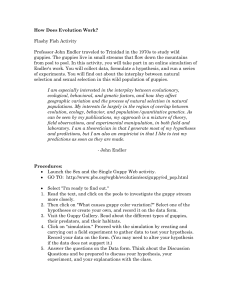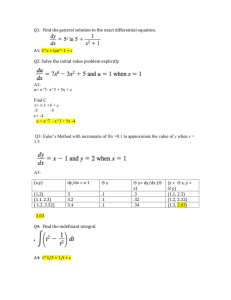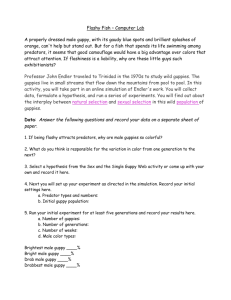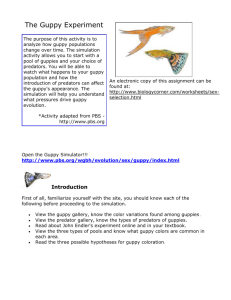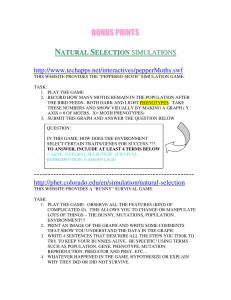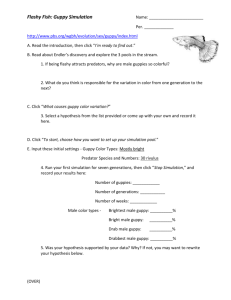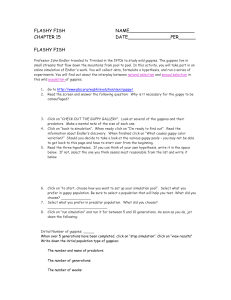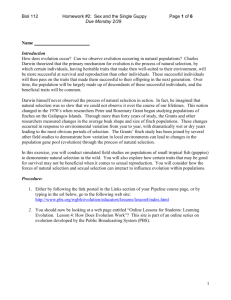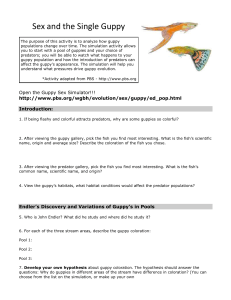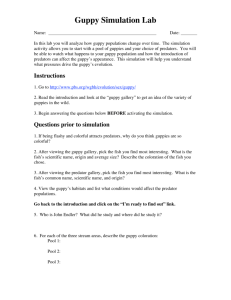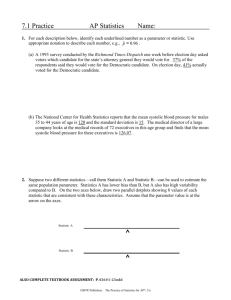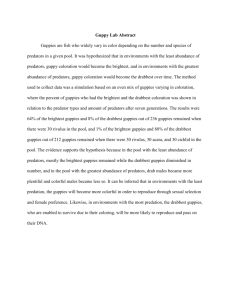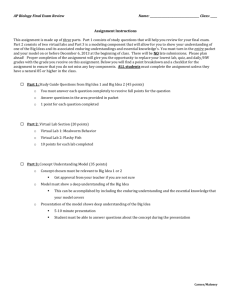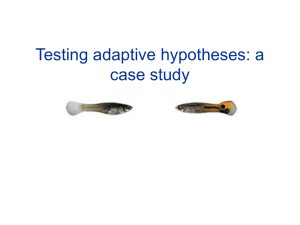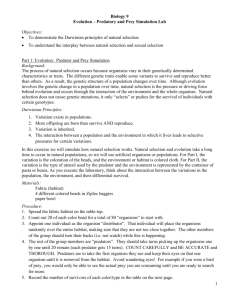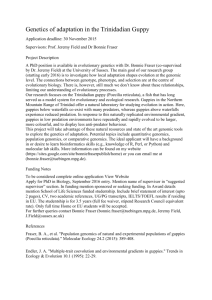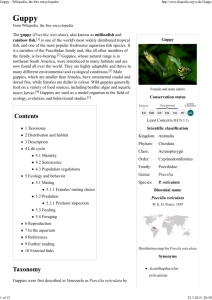Bio 100 Plus Hour Assignment
advertisement
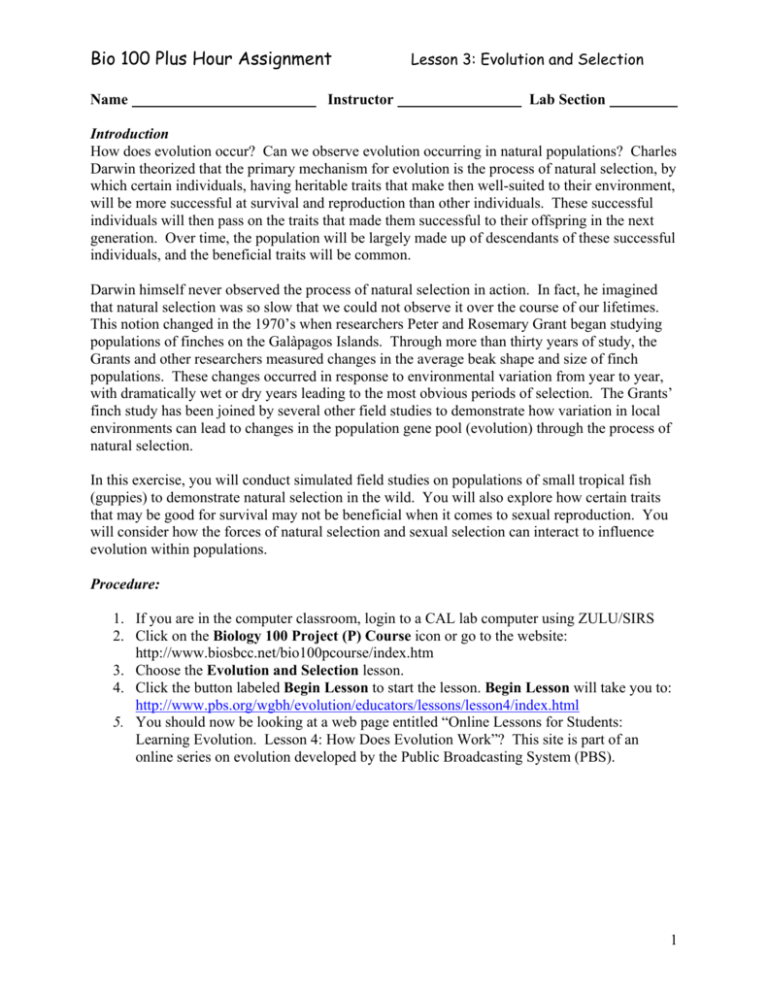
Bio 100 Plus Hour Assignment Name Instructor Lesson 3: Evolution and Selection Lab Section Introduction How does evolution occur? Can we observe evolution occurring in natural populations? Charles Darwin theorized that the primary mechanism for evolution is the process of natural selection, by which certain individuals, having heritable traits that make then well-suited to their environment, will be more successful at survival and reproduction than other individuals. These successful individuals will then pass on the traits that made them successful to their offspring in the next generation. Over time, the population will be largely made up of descendants of these successful individuals, and the beneficial traits will be common. Darwin himself never observed the process of natural selection in action. In fact, he imagined that natural selection was so slow that we could not observe it over the course of our lifetimes. This notion changed in the 1970’s when researchers Peter and Rosemary Grant began studying populations of finches on the Galàpagos Islands. Through more than thirty years of study, the Grants and other researchers measured changes in the average beak shape and size of finch populations. These changes occurred in response to environmental variation from year to year, with dramatically wet or dry years leading to the most obvious periods of selection. The Grants’ finch study has been joined by several other field studies to demonstrate how variation in local environments can lead to changes in the population gene pool (evolution) through the process of natural selection. In this exercise, you will conduct simulated field studies on populations of small tropical fish (guppies) to demonstrate natural selection in the wild. You will also explore how certain traits that may be good for survival may not be beneficial when it comes to sexual reproduction. You will consider how the forces of natural selection and sexual selection can interact to influence evolution within populations. Procedure: 1. If you are in the computer classroom, login to a CAL lab computer using ZULU/SIRS 2. Click on the Biology 100 Project (P) Course icon or go to the website: http://www.biosbcc.net/bio100pcourse/index.htm 3. Choose the Evolution and Selection lesson. 4. Click the button labeled Begin Lesson to start the lesson. Begin Lesson will take you to: http://www.pbs.org/wgbh/evolution/educators/lessons/lesson4/index.html 5. You should now be looking at a web page entitled “Online Lessons for Students: Learning Evolution. Lesson 4: How Does Evolution Work”? This site is part of an online series on evolution developed by the Public Broadcasting System (PBS). 1 Bio 100 Plus Hour Assignment Lesson 3: Evolution and Selection Questions # Using either the links provided on the right-hand column labeled “Scientific Terms”, your textbook, or class notes, define the following terms: • Evolution: • Population: • Natural Selection: • Sexual Selection: 6. Click on Activity 2: Flashy Fish. This activity is based on the research of John Endler, Professor of Ecology, Evolution, and Marine Biology at the University of California at Santa Barbara (UCSB). For years, Endler has studied several populations of guppies in the mountain streams of Trinidad. 7. Read the introductory paragraph under Activity 2: Flashy Fish. As you go through this activity, follow the procedures listed on these assignment pages, rather than those listed on the website. This procedure is adapted from that provided online. 8. Click on Sex and the Single Guppy (Flash) under the picture icon in the Procedures section. Note: You will need Adobe Shockwave Player to successfully run this simulation. If you are working the CAL lab, all computers should be equipped with Shockwave. If you are working at your home computer, you can download Shockwave from http://www.adobe.com/products/shockwaveplayer/. 9. Read the text and click on “check out the guppy gallery” at the bottom to see what male guppies look like (note the variation in color). 2 Bio 100 Plus Hour Assignment Lesson 3: Evolution and Selection 10. Click on “Predators” and “Habitats”, in the lower right corner, to see the guppies’ predators and the habitats in which guppies live. Question # • Give the common and scientific names of three guppy predators. 11. Click on “Back to Simulation.” 12. Click on “I’m ready to find out.” 13. Read the text, and click on the pools to investigate the guppy stream more closely. To return to the text page, simply click the X in the orange framed pool box. Question # • As you have seen, male guppies exhibit a wide variety of color and spot patterns. What do you think causes this color variation? Click on “What causes guppy variation?” for a list of potential hypotheses. You are to either come up with your own hypothesis, or select one from those listed. Your hypothesis: 14. After you have reviewed chosen your hypothesis, you will proceed with the simulation by setting up an experiment to determine some influences on guppy coloration. Click on “To start, choose how you want to set up your simulation pool.” 15. Read this page, and select your guppy types and predator species/numbers. (Note: Rivulus is the least effective guppy predator). Record your initial settings here: Guppy color types: __________________________________ Predator species and numbers: _________________________ 3 Bio 100 Plus Hour Assignment Lesson 3: Evolution and Selection 16. Run your initial experiment/simulation for at least seven generations and record your results here: Number of guppies: Number of generations: Number of weeks: Male color types: Brightest male guppies: _____% Bright male guppies: _____% Drab male guppies: _____% Drabbest male guppies: _____% 17. Click on “Results” to see an analysis of your results. Questions # • Do these results support your hypothesis? Explain why or why not. • If your initial hypothesis was not supported by your data, you may want to choose another hypothesis to answer the question, “What causes color variation?”. If so, enter your new hypothesis here: Your new hypothesis (if applicable): 4 Bio 100 Plus Hour Assignment Lesson 3: Evolution and Selection 18. Click on “Run Another Simulation,” and select new settings. Do this even if your hypothesis was supported by the results of your first run. Enter your new settings here: Guppy color types: __________________________________ Predator species and numbers: __________________________ 19. Run your new experiment/simulation for at least seven generations and record your results here: Number of guppies: Number of generations: Number of weeks: Male color types: Brightest male guppies: _____% Bright male guppies: _____% Drab male guppies: _____% Drabbest male guppies: _____% 20. Click on “Results” to see an analysis of your results. Question # • Do these results support your hypothesis? Explain why or why not. 21. After you have completed your second simulation and reviewed the results, Click on “Read Summary.” 22. Read this summary carefully, and if you desire, run more simulations putting to test the knowledge you have just learned. 5 Bio 100 Plus Hour Assignment Lesson 3: Evolution and Selection 23. Use the information gained in the Summary to answer the discussion questions below: # Discussion Questions: • Based on the results of your experiments/simulations, would you say that guppy coloration is heritable (that is, is it genetically determined)? Why or why not? • What role does color play in guppy survival? • What role does color play in guppy reproduction? • How are the forces of predation and sexual selection at odds in these guppy populations? • Male guppies are often brightly colored, while females are always drab. How would you explain this difference between males and females within this species? 6
